Report on the Fundamental Shift in Organizations and Implications
VerifiedAdded on 2021/06/17
|16
|3779
|20
Report
AI Summary
This report explores the fundamental shift in the nature of organizations, analyzing the transition from traditional hierarchical structures to modern, network-based models. It examines the implications of this shift, particularly focusing on organizational culture and managerial control, drawing upon M. Castell's theory of the network society. The report investigates how the rise of technology and globalization has reshaped organizational dynamics, emphasizing the move towards flatter hierarchies, team-based work, and decentralized decision-making. It also discusses the challenges and opportunities for organizations adapting to these changes, including the need for flexible structures, effective communication, and a strong emphasis on employee engagement. The report highlights the evolution of organizational culture, the role of managers in shaping it, and the impact of these changes on overall business performance. Finally, the report concludes with a discussion on the future of organizations in the context of the ongoing shift towards a more interconnected and dynamic business environment.
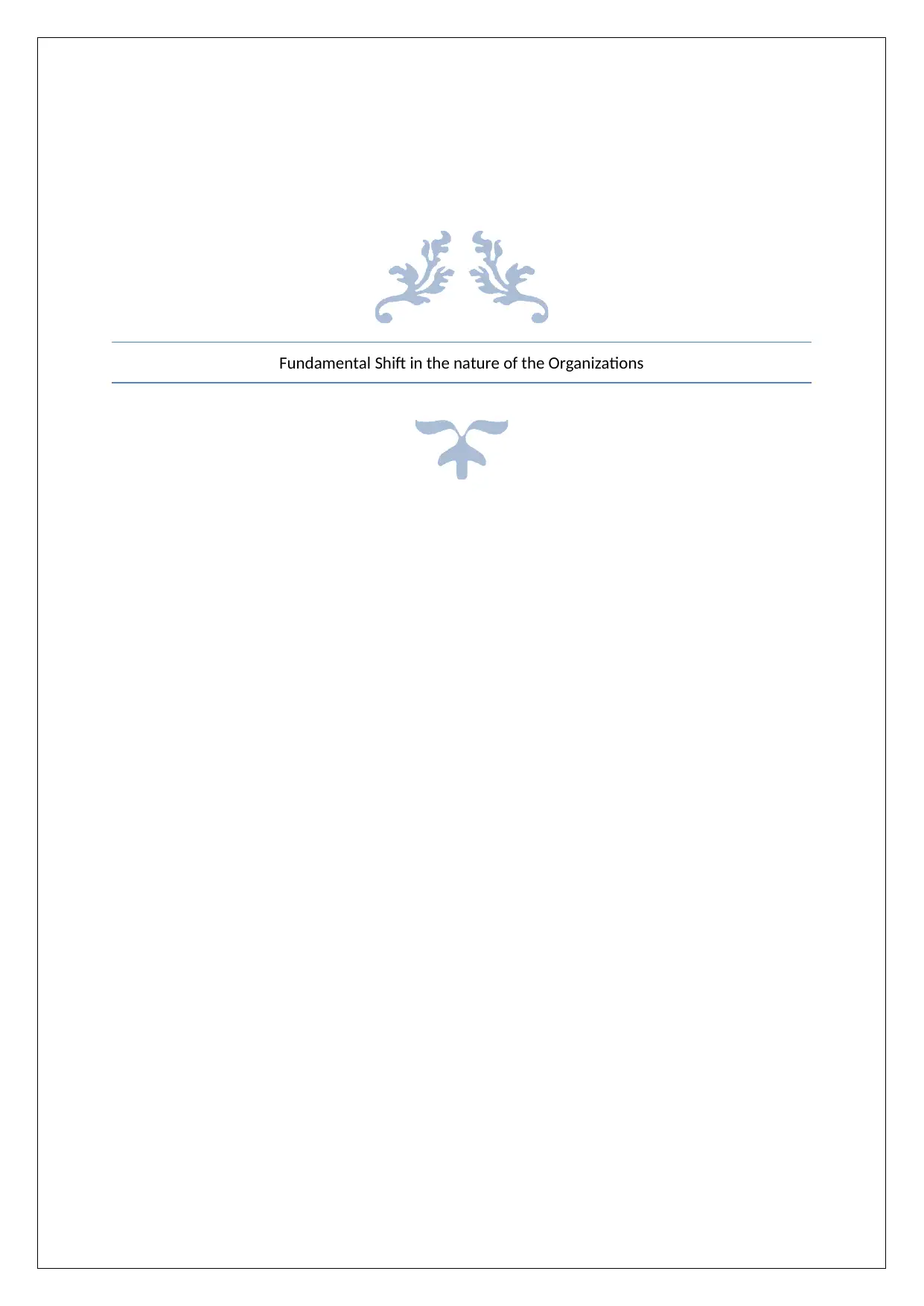
Fundamental Shift in the nature of the Organizations
Paraphrase This Document
Need a fresh take? Get an instant paraphrase of this document with our AI Paraphraser
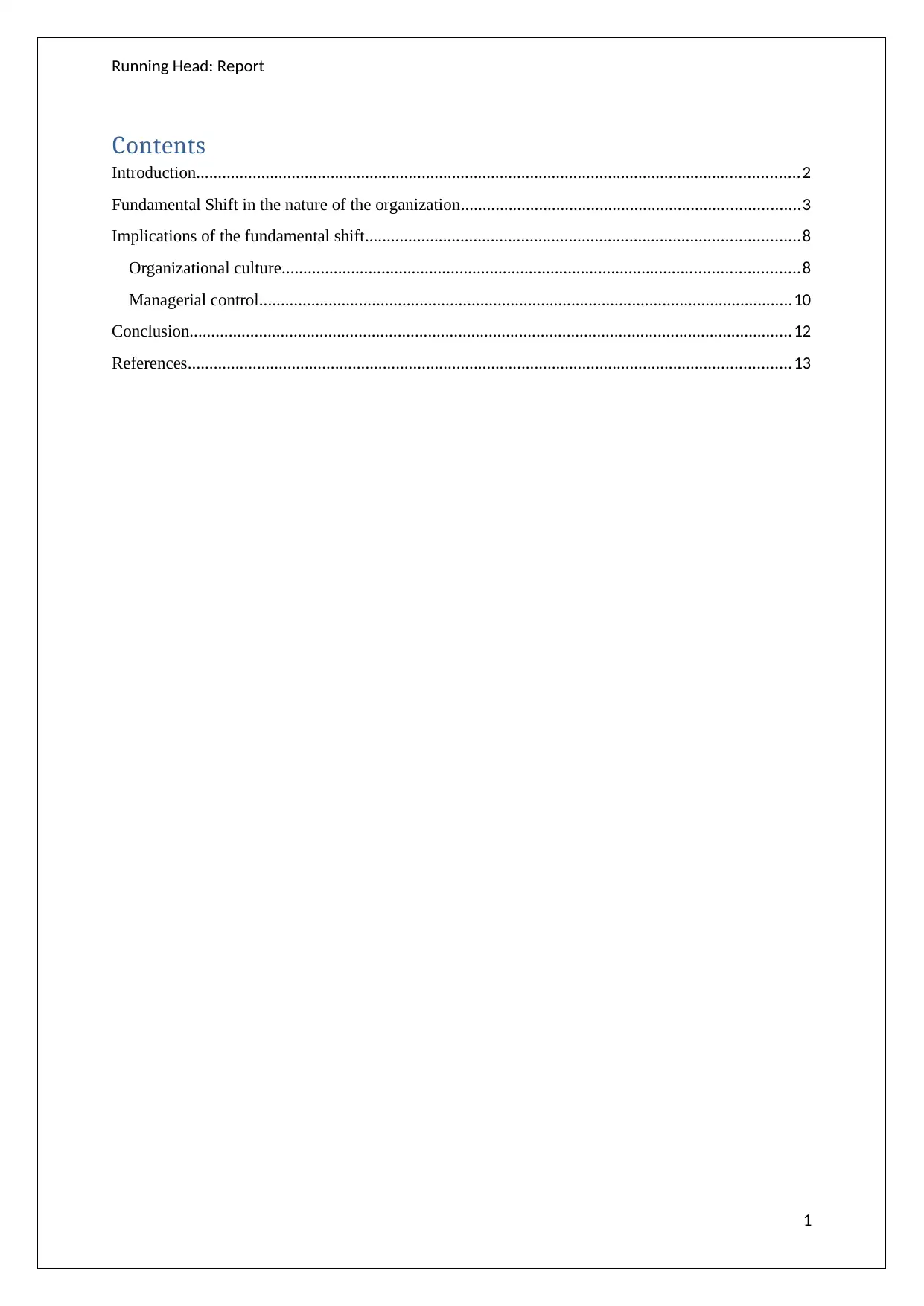
Running Head: Report
Contents
Introduction...........................................................................................................................................2
Fundamental Shift in the nature of the organization..............................................................................3
Implications of the fundamental shift....................................................................................................8
Organizational culture.......................................................................................................................8
Managerial control...........................................................................................................................10
Conclusion...........................................................................................................................................12
References...........................................................................................................................................13
1
Contents
Introduction...........................................................................................................................................2
Fundamental Shift in the nature of the organization..............................................................................3
Implications of the fundamental shift....................................................................................................8
Organizational culture.......................................................................................................................8
Managerial control...........................................................................................................................10
Conclusion...........................................................................................................................................12
References...........................................................................................................................................13
1
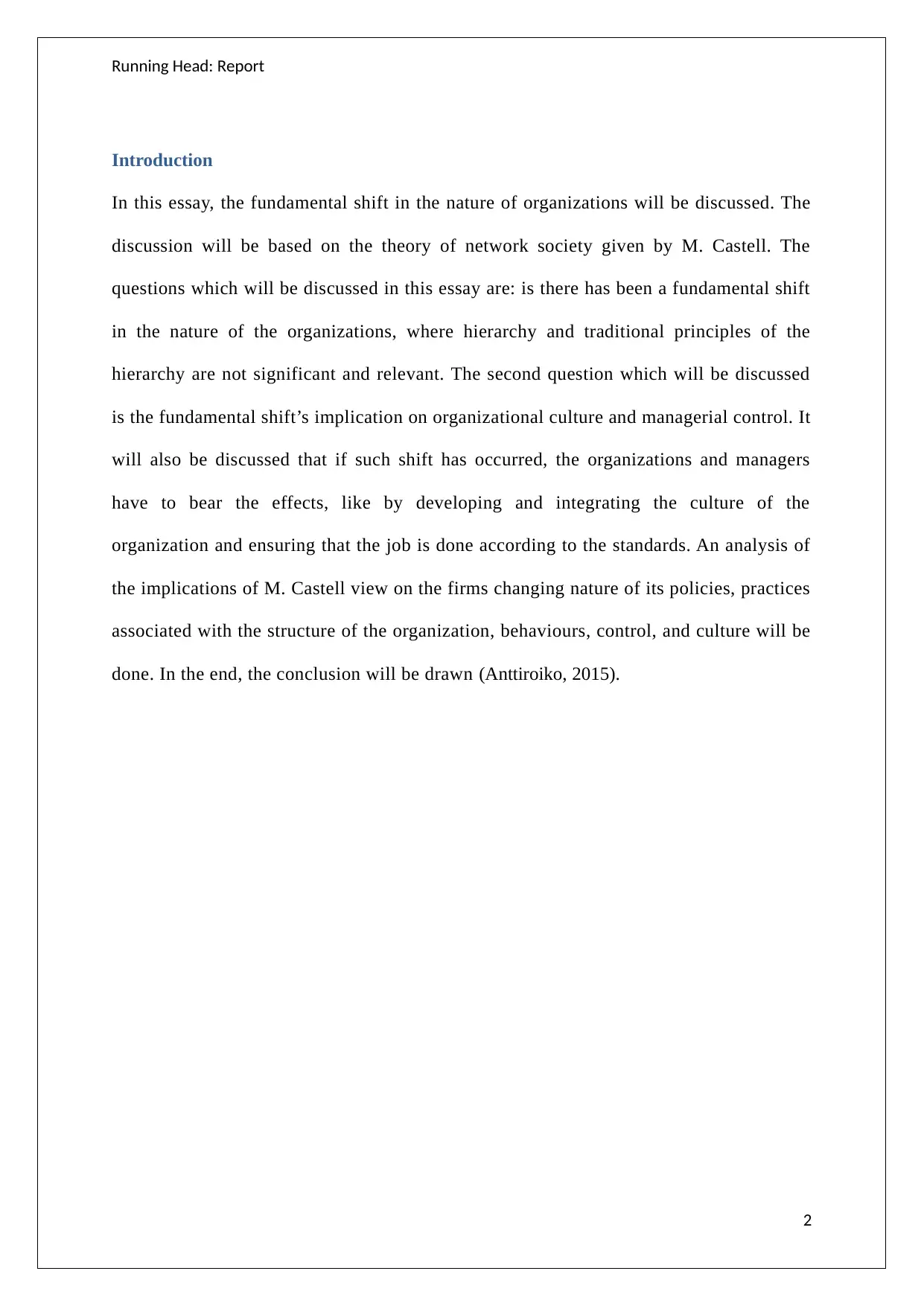
Running Head: Report
Introduction
In this essay, the fundamental shift in the nature of organizations will be discussed. The
discussion will be based on the theory of network society given by M. Castell. The
questions which will be discussed in this essay are: is there has been a fundamental shift
in the nature of the organizations, where hierarchy and traditional principles of the
hierarchy are not significant and relevant. The second question which will be discussed
is the fundamental shift’s implication on organizational culture and managerial control. It
will also be discussed that if such shift has occurred, the organizations and managers
have to bear the effects, like by developing and integrating the culture of the
organization and ensuring that the job is done according to the standards. An analysis of
the implications of M. Castell view on the firms changing nature of its policies, practices
associated with the structure of the organization, behaviours, control, and culture will be
done. In the end, the conclusion will be drawn (Anttiroiko, 2015).
2
Introduction
In this essay, the fundamental shift in the nature of organizations will be discussed. The
discussion will be based on the theory of network society given by M. Castell. The
questions which will be discussed in this essay are: is there has been a fundamental shift
in the nature of the organizations, where hierarchy and traditional principles of the
hierarchy are not significant and relevant. The second question which will be discussed
is the fundamental shift’s implication on organizational culture and managerial control. It
will also be discussed that if such shift has occurred, the organizations and managers
have to bear the effects, like by developing and integrating the culture of the
organization and ensuring that the job is done according to the standards. An analysis of
the implications of M. Castell view on the firms changing nature of its policies, practices
associated with the structure of the organization, behaviours, control, and culture will be
done. In the end, the conclusion will be drawn (Anttiroiko, 2015).
2
⊘ This is a preview!⊘
Do you want full access?
Subscribe today to unlock all pages.

Trusted by 1+ million students worldwide
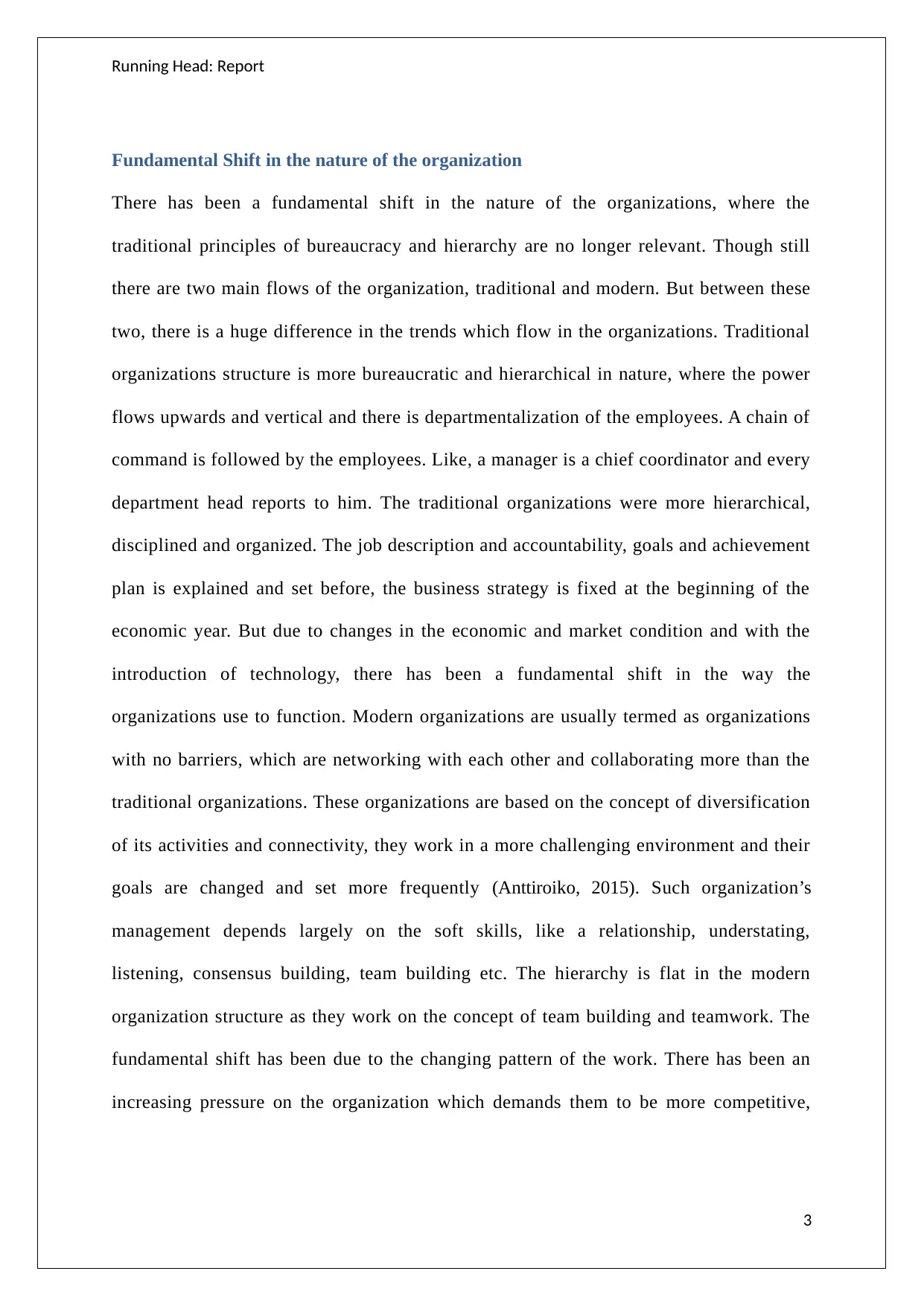
Running Head: Report
Fundamental Shift in the nature of the organization
There has been a fundamental shift in the nature of the organizations, where the
traditional principles of bureaucracy and hierarchy are no longer relevant. Though still
there are two main flows of the organization, traditional and modern. But between these
two, there is a huge difference in the trends which flow in the organizations. Traditional
organizations structure is more bureaucratic and hierarchical in nature, where the power
flows upwards and vertical and there is departmentalization of the employees. A chain of
command is followed by the employees. Like, a manager is a chief coordinator and every
department head reports to him. The traditional organizations were more hierarchical,
disciplined and organized. The job description and accountability, goals and achievement
plan is explained and set before, the business strategy is fixed at the beginning of the
economic year. But due to changes in the economic and market condition and with the
introduction of technology, there has been a fundamental shift in the way the
organizations use to function. Modern organizations are usually termed as organizations
with no barriers, which are networking with each other and collaborating more than the
traditional organizations. These organizations are based on the concept of diversification
of its activities and connectivity, they work in a more challenging environment and their
goals are changed and set more frequently (Anttiroiko, 2015). Such organization’s
management depends largely on the soft skills, like a relationship, understating,
listening, consensus building, team building etc. The hierarchy is flat in the modern
organization structure as they work on the concept of team building and teamwork. The
fundamental shift has been due to the changing pattern of the work. There has been an
increasing pressure on the organization which demands them to be more competitive,
3
Fundamental Shift in the nature of the organization
There has been a fundamental shift in the nature of the organizations, where the
traditional principles of bureaucracy and hierarchy are no longer relevant. Though still
there are two main flows of the organization, traditional and modern. But between these
two, there is a huge difference in the trends which flow in the organizations. Traditional
organizations structure is more bureaucratic and hierarchical in nature, where the power
flows upwards and vertical and there is departmentalization of the employees. A chain of
command is followed by the employees. Like, a manager is a chief coordinator and every
department head reports to him. The traditional organizations were more hierarchical,
disciplined and organized. The job description and accountability, goals and achievement
plan is explained and set before, the business strategy is fixed at the beginning of the
economic year. But due to changes in the economic and market condition and with the
introduction of technology, there has been a fundamental shift in the way the
organizations use to function. Modern organizations are usually termed as organizations
with no barriers, which are networking with each other and collaborating more than the
traditional organizations. These organizations are based on the concept of diversification
of its activities and connectivity, they work in a more challenging environment and their
goals are changed and set more frequently (Anttiroiko, 2015). Such organization’s
management depends largely on the soft skills, like a relationship, understating,
listening, consensus building, team building etc. The hierarchy is flat in the modern
organization structure as they work on the concept of team building and teamwork. The
fundamental shift has been due to the changing pattern of the work. There has been an
increasing pressure on the organization which demands them to be more competitive,
3
Paraphrase This Document
Need a fresh take? Get an instant paraphrase of this document with our AI Paraphraser
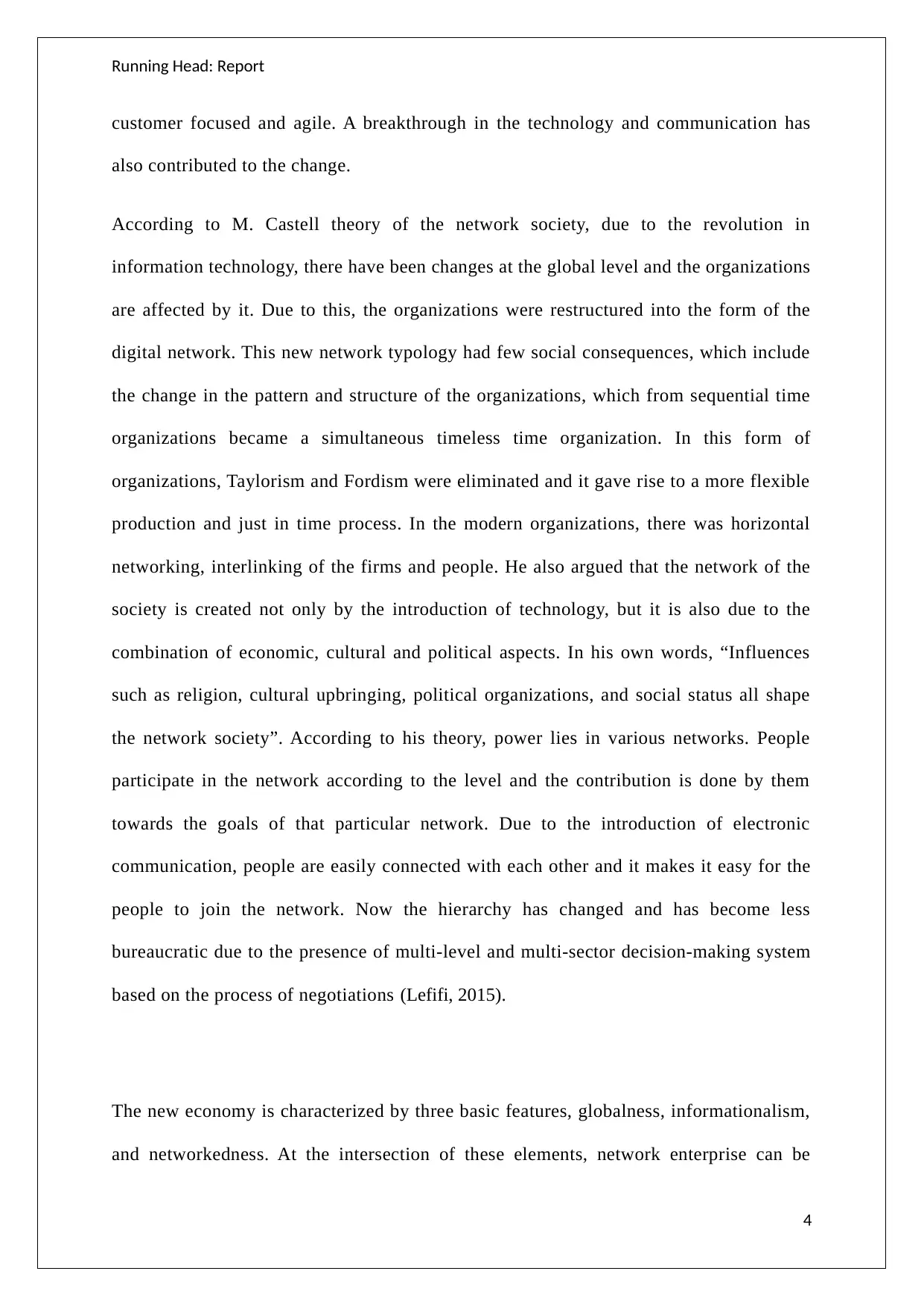
Running Head: Report
customer focused and agile. A breakthrough in the technology and communication has
also contributed to the change.
According to M. Castell theory of the network society, due to the revolution in
information technology, there have been changes at the global level and the organizations
are affected by it. Due to this, the organizations were restructured into the form of the
digital network. This new network typology had few social consequences, which include
the change in the pattern and structure of the organizations, which from sequential time
organizations became a simultaneous timeless time organization. In this form of
organizations, Taylorism and Fordism were eliminated and it gave rise to a more flexible
production and just in time process. In the modern organizations, there was horizontal
networking, interlinking of the firms and people. He also argued that the network of the
society is created not only by the introduction of technology, but it is also due to the
combination of economic, cultural and political aspects. In his own words, “Influences
such as religion, cultural upbringing, political organizations, and social status all shape
the network society”. According to his theory, power lies in various networks. People
participate in the network according to the level and the contribution is done by them
towards the goals of that particular network. Due to the introduction of electronic
communication, people are easily connected with each other and it makes it easy for the
people to join the network. Now the hierarchy has changed and has become less
bureaucratic due to the presence of multi-level and multi-sector decision-making system
based on the process of negotiations (Lefifi, 2015).
The new economy is characterized by three basic features, globalness, informationalism,
and networkedness. At the intersection of these elements, network enterprise can be
4
customer focused and agile. A breakthrough in the technology and communication has
also contributed to the change.
According to M. Castell theory of the network society, due to the revolution in
information technology, there have been changes at the global level and the organizations
are affected by it. Due to this, the organizations were restructured into the form of the
digital network. This new network typology had few social consequences, which include
the change in the pattern and structure of the organizations, which from sequential time
organizations became a simultaneous timeless time organization. In this form of
organizations, Taylorism and Fordism were eliminated and it gave rise to a more flexible
production and just in time process. In the modern organizations, there was horizontal
networking, interlinking of the firms and people. He also argued that the network of the
society is created not only by the introduction of technology, but it is also due to the
combination of economic, cultural and political aspects. In his own words, “Influences
such as religion, cultural upbringing, political organizations, and social status all shape
the network society”. According to his theory, power lies in various networks. People
participate in the network according to the level and the contribution is done by them
towards the goals of that particular network. Due to the introduction of electronic
communication, people are easily connected with each other and it makes it easy for the
people to join the network. Now the hierarchy has changed and has become less
bureaucratic due to the presence of multi-level and multi-sector decision-making system
based on the process of negotiations (Lefifi, 2015).
The new economy is characterized by three basic features, globalness, informationalism,
and networkedness. At the intersection of these elements, network enterprise can be
4
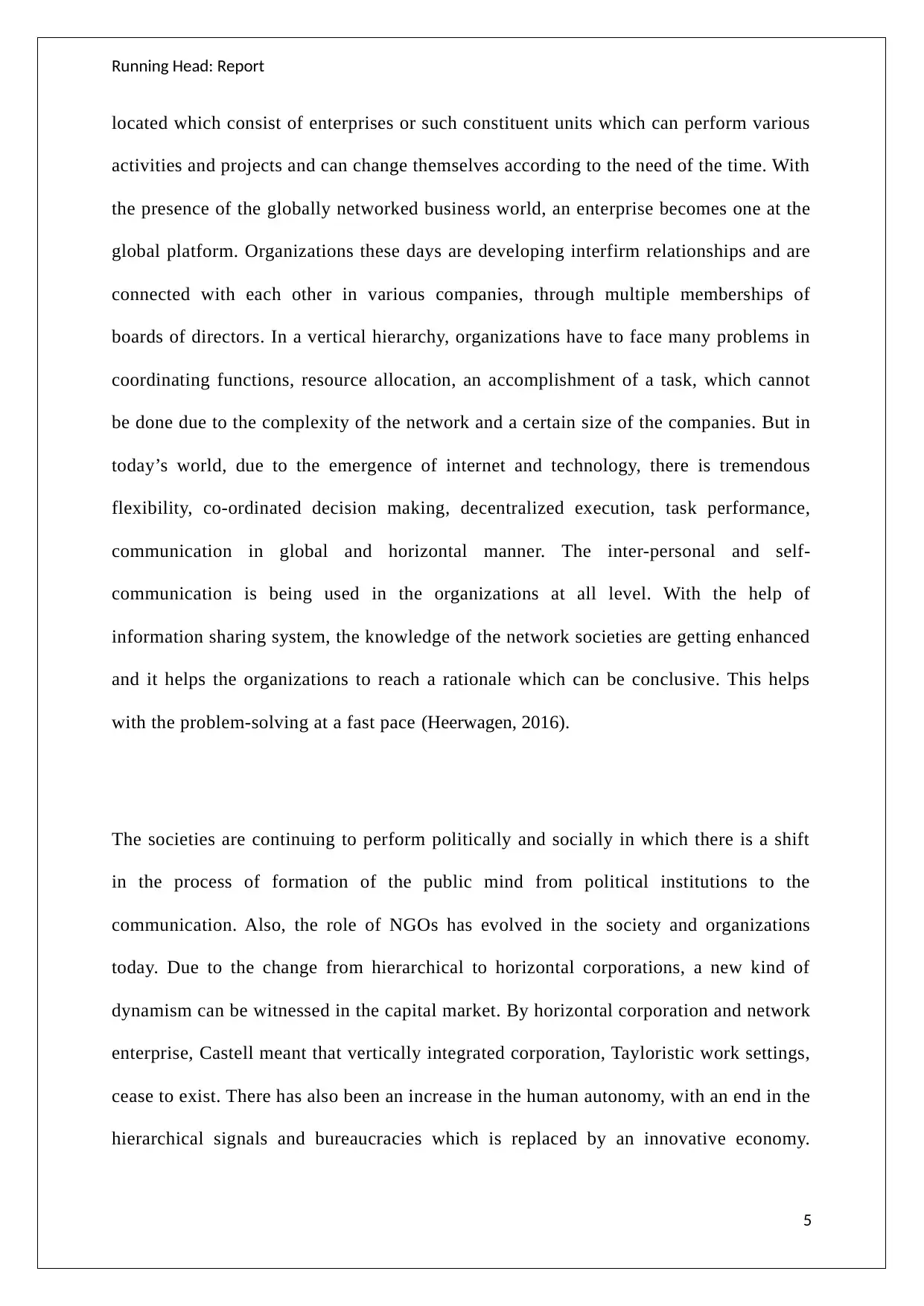
Running Head: Report
located which consist of enterprises or such constituent units which can perform various
activities and projects and can change themselves according to the need of the time. With
the presence of the globally networked business world, an enterprise becomes one at the
global platform. Organizations these days are developing interfirm relationships and are
connected with each other in various companies, through multiple memberships of
boards of directors. In a vertical hierarchy, organizations have to face many problems in
coordinating functions, resource allocation, an accomplishment of a task, which cannot
be done due to the complexity of the network and a certain size of the companies. But in
today’s world, due to the emergence of internet and technology, there is tremendous
flexibility, co-ordinated decision making, decentralized execution, task performance,
communication in global and horizontal manner. The inter-personal and self-
communication is being used in the organizations at all level. With the help of
information sharing system, the knowledge of the network societies are getting enhanced
and it helps the organizations to reach a rationale which can be conclusive. This helps
with the problem-solving at a fast pace (Heerwagen, 2016).
The societies are continuing to perform politically and socially in which there is a shift
in the process of formation of the public mind from political institutions to the
communication. Also, the role of NGOs has evolved in the society and organizations
today. Due to the change from hierarchical to horizontal corporations, a new kind of
dynamism can be witnessed in the capital market. By horizontal corporation and network
enterprise, Castell meant that vertically integrated corporation, Tayloristic work settings,
cease to exist. There has also been an increase in the human autonomy, with an end in the
hierarchical signals and bureaucracies which is replaced by an innovative economy.
5
located which consist of enterprises or such constituent units which can perform various
activities and projects and can change themselves according to the need of the time. With
the presence of the globally networked business world, an enterprise becomes one at the
global platform. Organizations these days are developing interfirm relationships and are
connected with each other in various companies, through multiple memberships of
boards of directors. In a vertical hierarchy, organizations have to face many problems in
coordinating functions, resource allocation, an accomplishment of a task, which cannot
be done due to the complexity of the network and a certain size of the companies. But in
today’s world, due to the emergence of internet and technology, there is tremendous
flexibility, co-ordinated decision making, decentralized execution, task performance,
communication in global and horizontal manner. The inter-personal and self-
communication is being used in the organizations at all level. With the help of
information sharing system, the knowledge of the network societies are getting enhanced
and it helps the organizations to reach a rationale which can be conclusive. This helps
with the problem-solving at a fast pace (Heerwagen, 2016).
The societies are continuing to perform politically and socially in which there is a shift
in the process of formation of the public mind from political institutions to the
communication. Also, the role of NGOs has evolved in the society and organizations
today. Due to the change from hierarchical to horizontal corporations, a new kind of
dynamism can be witnessed in the capital market. By horizontal corporation and network
enterprise, Castell meant that vertically integrated corporation, Tayloristic work settings,
cease to exist. There has also been an increase in the human autonomy, with an end in the
hierarchical signals and bureaucracies which is replaced by an innovative economy.
5
⊘ This is a preview!⊘
Do you want full access?
Subscribe today to unlock all pages.

Trusted by 1+ million students worldwide
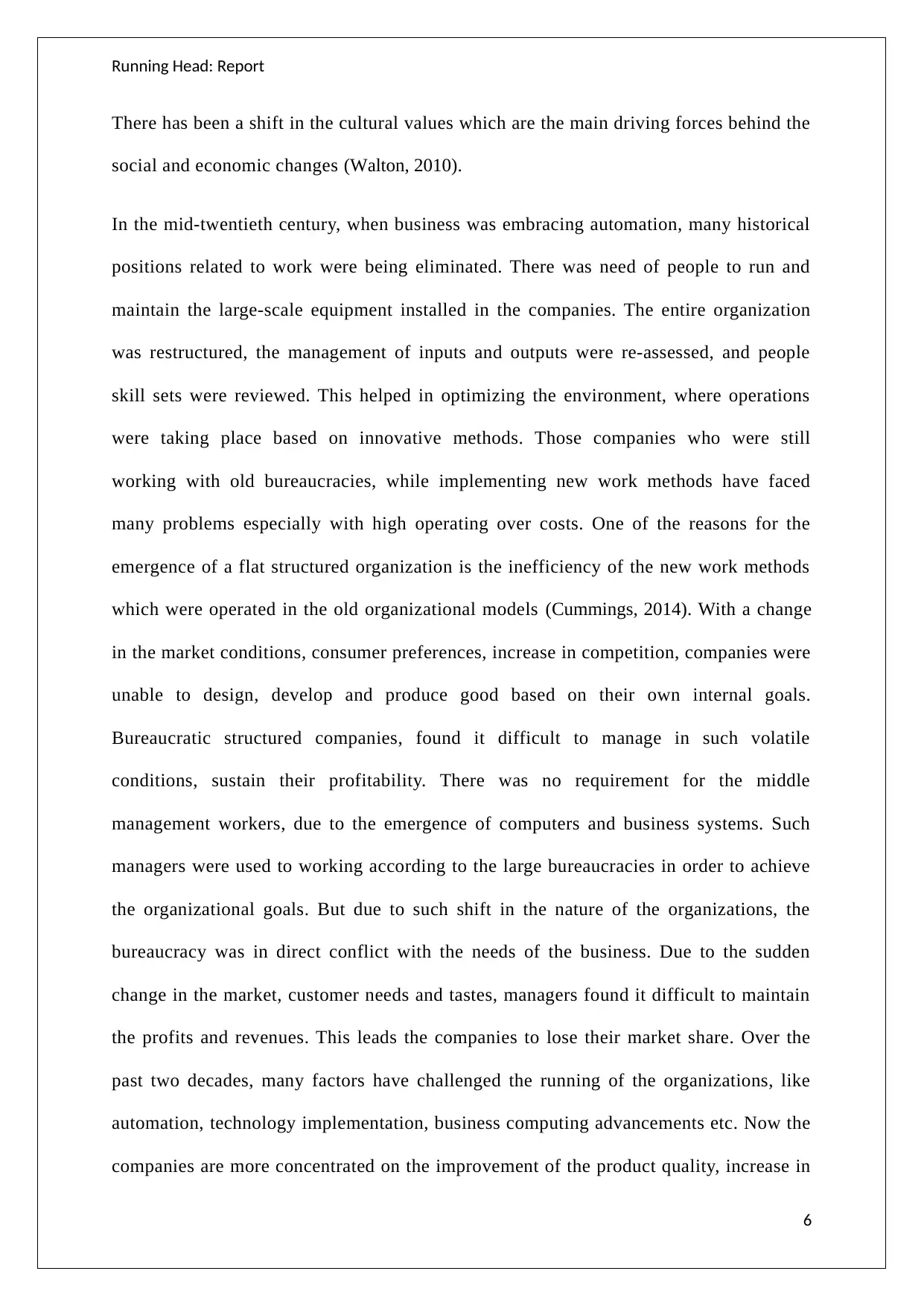
Running Head: Report
There has been a shift in the cultural values which are the main driving forces behind the
social and economic changes (Walton, 2010).
In the mid-twentieth century, when business was embracing automation, many historical
positions related to work were being eliminated. There was need of people to run and
maintain the large-scale equipment installed in the companies. The entire organization
was restructured, the management of inputs and outputs were re-assessed, and people
skill sets were reviewed. This helped in optimizing the environment, where operations
were taking place based on innovative methods. Those companies who were still
working with old bureaucracies, while implementing new work methods have faced
many problems especially with high operating over costs. One of the reasons for the
emergence of a flat structured organization is the inefficiency of the new work methods
which were operated in the old organizational models (Cummings, 2014). With a change
in the market conditions, consumer preferences, increase in competition, companies were
unable to design, develop and produce good based on their own internal goals.
Bureaucratic structured companies, found it difficult to manage in such volatile
conditions, sustain their profitability. There was no requirement for the middle
management workers, due to the emergence of computers and business systems. Such
managers were used to working according to the large bureaucracies in order to achieve
the organizational goals. But due to such shift in the nature of the organizations, the
bureaucracy was in direct conflict with the needs of the business. Due to the sudden
change in the market, customer needs and tastes, managers found it difficult to maintain
the profits and revenues. This leads the companies to lose their market share. Over the
past two decades, many factors have challenged the running of the organizations, like
automation, technology implementation, business computing advancements etc. Now the
companies are more concentrated on the improvement of the product quality, increase in
6
There has been a shift in the cultural values which are the main driving forces behind the
social and economic changes (Walton, 2010).
In the mid-twentieth century, when business was embracing automation, many historical
positions related to work were being eliminated. There was need of people to run and
maintain the large-scale equipment installed in the companies. The entire organization
was restructured, the management of inputs and outputs were re-assessed, and people
skill sets were reviewed. This helped in optimizing the environment, where operations
were taking place based on innovative methods. Those companies who were still
working with old bureaucracies, while implementing new work methods have faced
many problems especially with high operating over costs. One of the reasons for the
emergence of a flat structured organization is the inefficiency of the new work methods
which were operated in the old organizational models (Cummings, 2014). With a change
in the market conditions, consumer preferences, increase in competition, companies were
unable to design, develop and produce good based on their own internal goals.
Bureaucratic structured companies, found it difficult to manage in such volatile
conditions, sustain their profitability. There was no requirement for the middle
management workers, due to the emergence of computers and business systems. Such
managers were used to working according to the large bureaucracies in order to achieve
the organizational goals. But due to such shift in the nature of the organizations, the
bureaucracy was in direct conflict with the needs of the business. Due to the sudden
change in the market, customer needs and tastes, managers found it difficult to maintain
the profits and revenues. This leads the companies to lose their market share. Over the
past two decades, many factors have challenged the running of the organizations, like
automation, technology implementation, business computing advancements etc. Now the
companies are more concentrated on the improvement of the product quality, increase in
6
Paraphrase This Document
Need a fresh take? Get an instant paraphrase of this document with our AI Paraphraser
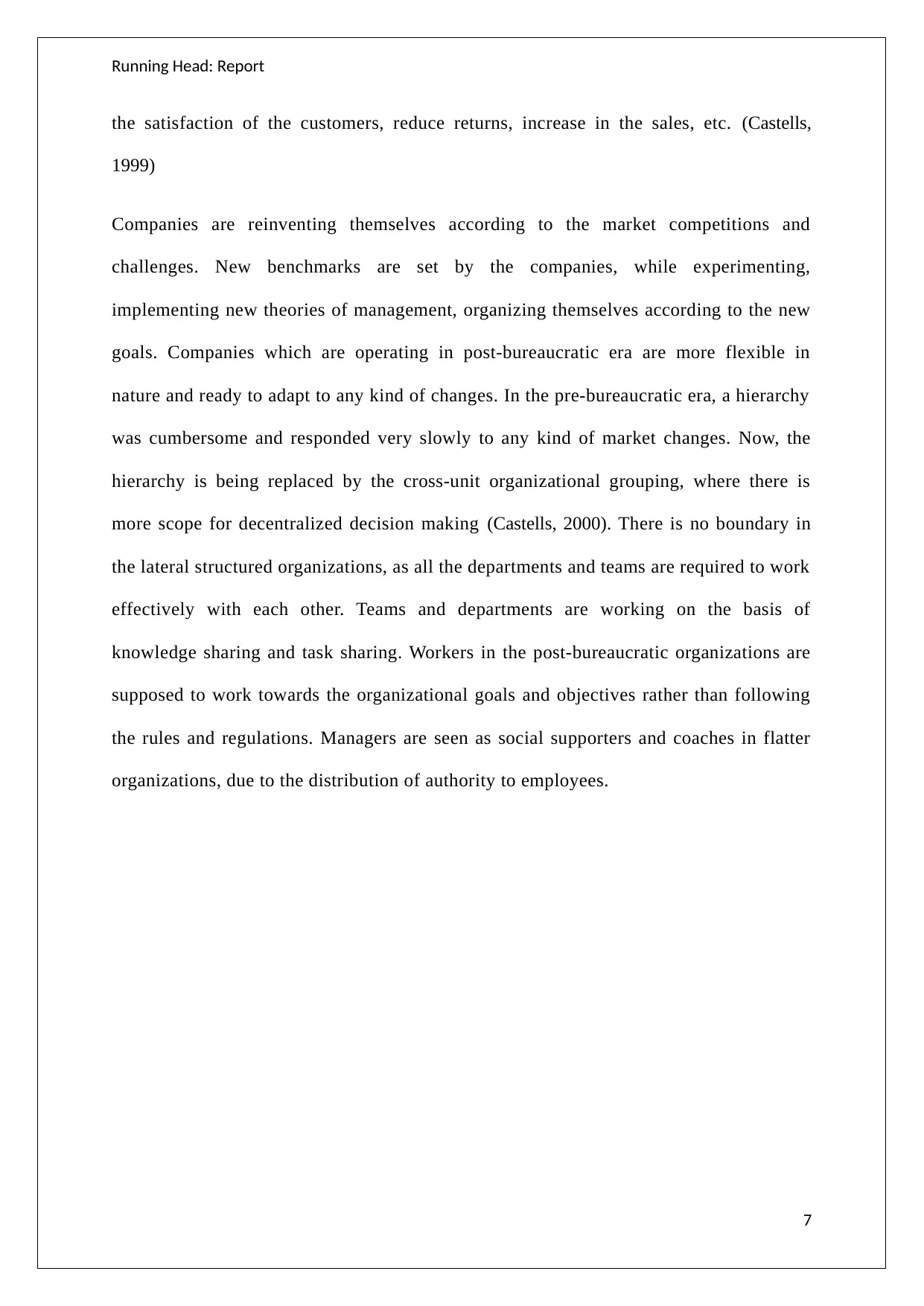
Running Head: Report
the satisfaction of the customers, reduce returns, increase in the sales, etc. (Castells,
1999)
Companies are reinventing themselves according to the market competitions and
challenges. New benchmarks are set by the companies, while experimenting,
implementing new theories of management, organizing themselves according to the new
goals. Companies which are operating in post-bureaucratic era are more flexible in
nature and ready to adapt to any kind of changes. In the pre-bureaucratic era, a hierarchy
was cumbersome and responded very slowly to any kind of market changes. Now, the
hierarchy is being replaced by the cross-unit organizational grouping, where there is
more scope for decentralized decision making (Castells, 2000). There is no boundary in
the lateral structured organizations, as all the departments and teams are required to work
effectively with each other. Teams and departments are working on the basis of
knowledge sharing and task sharing. Workers in the post-bureaucratic organizations are
supposed to work towards the organizational goals and objectives rather than following
the rules and regulations. Managers are seen as social supporters and coaches in flatter
organizations, due to the distribution of authority to employees.
7
the satisfaction of the customers, reduce returns, increase in the sales, etc. (Castells,
1999)
Companies are reinventing themselves according to the market competitions and
challenges. New benchmarks are set by the companies, while experimenting,
implementing new theories of management, organizing themselves according to the new
goals. Companies which are operating in post-bureaucratic era are more flexible in
nature and ready to adapt to any kind of changes. In the pre-bureaucratic era, a hierarchy
was cumbersome and responded very slowly to any kind of market changes. Now, the
hierarchy is being replaced by the cross-unit organizational grouping, where there is
more scope for decentralized decision making (Castells, 2000). There is no boundary in
the lateral structured organizations, as all the departments and teams are required to work
effectively with each other. Teams and departments are working on the basis of
knowledge sharing and task sharing. Workers in the post-bureaucratic organizations are
supposed to work towards the organizational goals and objectives rather than following
the rules and regulations. Managers are seen as social supporters and coaches in flatter
organizations, due to the distribution of authority to employees.
7
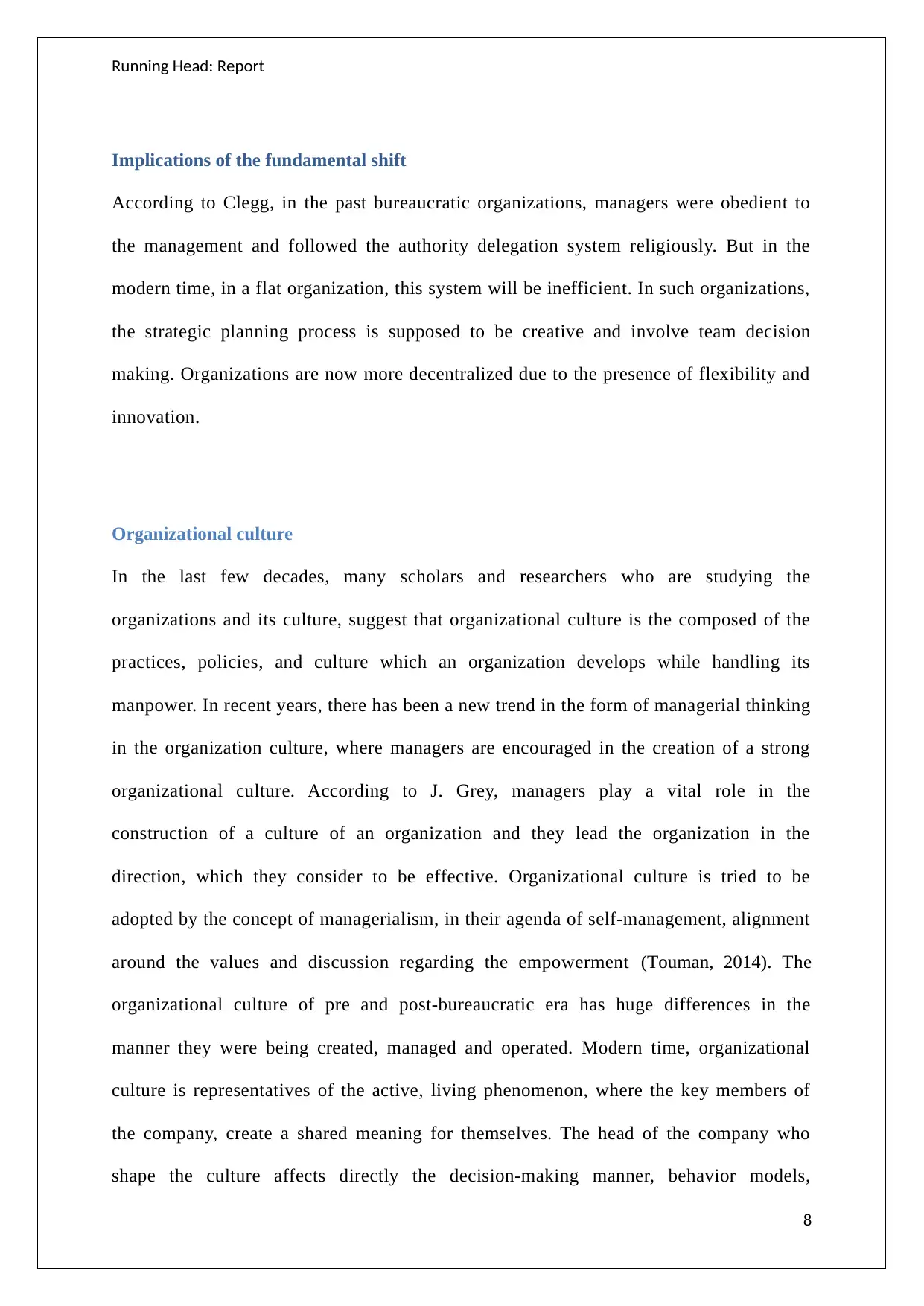
Running Head: Report
Implications of the fundamental shift
According to Clegg, in the past bureaucratic organizations, managers were obedient to
the management and followed the authority delegation system religiously. But in the
modern time, in a flat organization, this system will be inefficient. In such organizations,
the strategic planning process is supposed to be creative and involve team decision
making. Organizations are now more decentralized due to the presence of flexibility and
innovation.
Organizational culture
In the last few decades, many scholars and researchers who are studying the
organizations and its culture, suggest that organizational culture is the composed of the
practices, policies, and culture which an organization develops while handling its
manpower. In recent years, there has been a new trend in the form of managerial thinking
in the organization culture, where managers are encouraged in the creation of a strong
organizational culture. According to J. Grey, managers play a vital role in the
construction of a culture of an organization and they lead the organization in the
direction, which they consider to be effective. Organizational culture is tried to be
adopted by the concept of managerialism, in their agenda of self-management, alignment
around the values and discussion regarding the empowerment (Touman, 2014). The
organizational culture of pre and post-bureaucratic era has huge differences in the
manner they were being created, managed and operated. Modern time, organizational
culture is representatives of the active, living phenomenon, where the key members of
the company, create a shared meaning for themselves. The head of the company who
shape the culture affects directly the decision-making manner, behavior models,
8
Implications of the fundamental shift
According to Clegg, in the past bureaucratic organizations, managers were obedient to
the management and followed the authority delegation system religiously. But in the
modern time, in a flat organization, this system will be inefficient. In such organizations,
the strategic planning process is supposed to be creative and involve team decision
making. Organizations are now more decentralized due to the presence of flexibility and
innovation.
Organizational culture
In the last few decades, many scholars and researchers who are studying the
organizations and its culture, suggest that organizational culture is the composed of the
practices, policies, and culture which an organization develops while handling its
manpower. In recent years, there has been a new trend in the form of managerial thinking
in the organization culture, where managers are encouraged in the creation of a strong
organizational culture. According to J. Grey, managers play a vital role in the
construction of a culture of an organization and they lead the organization in the
direction, which they consider to be effective. Organizational culture is tried to be
adopted by the concept of managerialism, in their agenda of self-management, alignment
around the values and discussion regarding the empowerment (Touman, 2014). The
organizational culture of pre and post-bureaucratic era has huge differences in the
manner they were being created, managed and operated. Modern time, organizational
culture is representatives of the active, living phenomenon, where the key members of
the company, create a shared meaning for themselves. The head of the company who
shape the culture affects directly the decision-making manner, behavior models,
8
⊘ This is a preview!⊘
Do you want full access?
Subscribe today to unlock all pages.

Trusted by 1+ million students worldwide
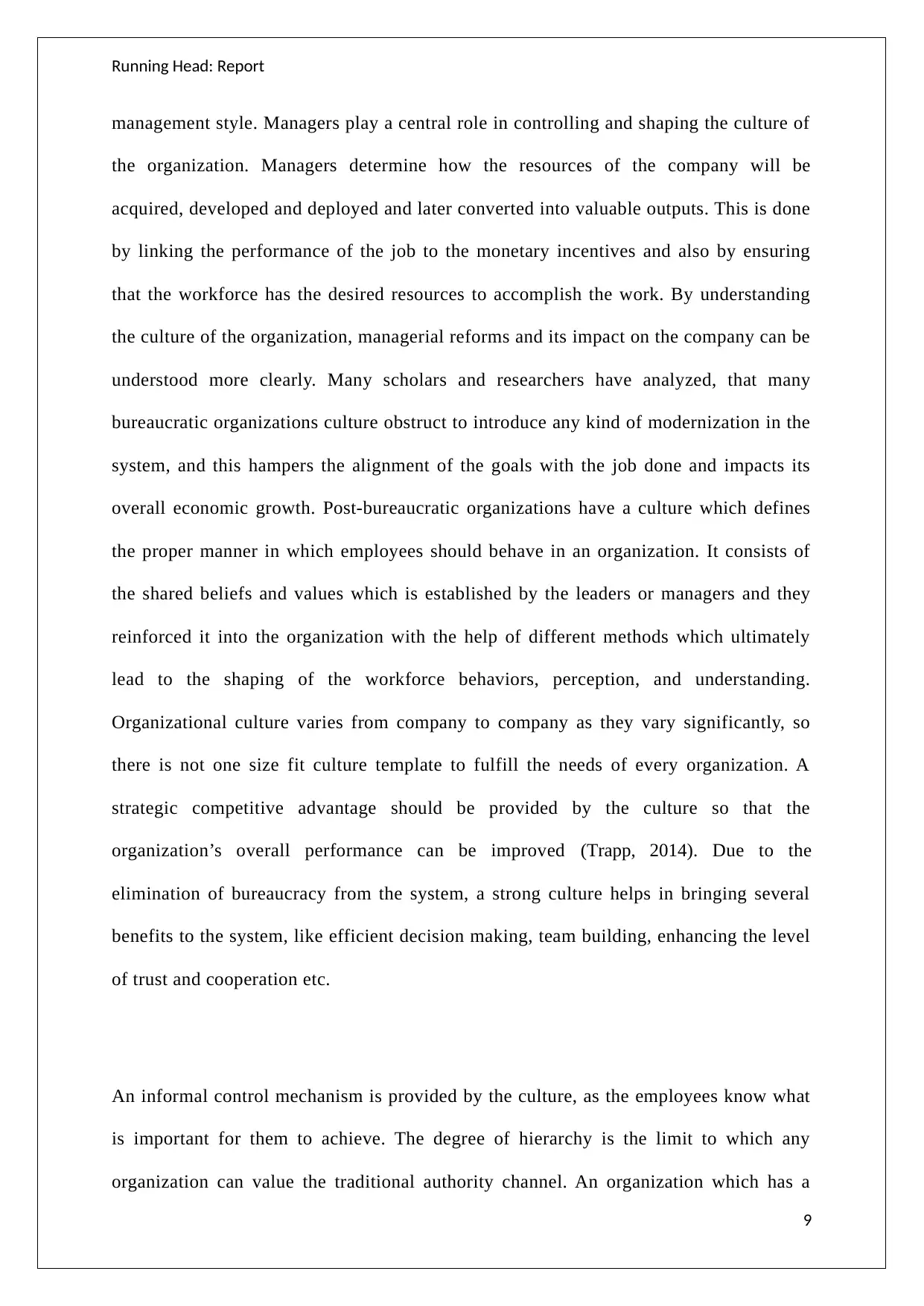
Running Head: Report
management style. Managers play a central role in controlling and shaping the culture of
the organization. Managers determine how the resources of the company will be
acquired, developed and deployed and later converted into valuable outputs. This is done
by linking the performance of the job to the monetary incentives and also by ensuring
that the workforce has the desired resources to accomplish the work. By understanding
the culture of the organization, managerial reforms and its impact on the company can be
understood more clearly. Many scholars and researchers have analyzed, that many
bureaucratic organizations culture obstruct to introduce any kind of modernization in the
system, and this hampers the alignment of the goals with the job done and impacts its
overall economic growth. Post-bureaucratic organizations have a culture which defines
the proper manner in which employees should behave in an organization. It consists of
the shared beliefs and values which is established by the leaders or managers and they
reinforced it into the organization with the help of different methods which ultimately
lead to the shaping of the workforce behaviors, perception, and understanding.
Organizational culture varies from company to company as they vary significantly, so
there is not one size fit culture template to fulfill the needs of every organization. A
strategic competitive advantage should be provided by the culture so that the
organization’s overall performance can be improved (Trapp, 2014). Due to the
elimination of bureaucracy from the system, a strong culture helps in bringing several
benefits to the system, like efficient decision making, team building, enhancing the level
of trust and cooperation etc.
An informal control mechanism is provided by the culture, as the employees know what
is important for them to achieve. The degree of hierarchy is the limit to which any
organization can value the traditional authority channel. An organization which has a
9
management style. Managers play a central role in controlling and shaping the culture of
the organization. Managers determine how the resources of the company will be
acquired, developed and deployed and later converted into valuable outputs. This is done
by linking the performance of the job to the monetary incentives and also by ensuring
that the workforce has the desired resources to accomplish the work. By understanding
the culture of the organization, managerial reforms and its impact on the company can be
understood more clearly. Many scholars and researchers have analyzed, that many
bureaucratic organizations culture obstruct to introduce any kind of modernization in the
system, and this hampers the alignment of the goals with the job done and impacts its
overall economic growth. Post-bureaucratic organizations have a culture which defines
the proper manner in which employees should behave in an organization. It consists of
the shared beliefs and values which is established by the leaders or managers and they
reinforced it into the organization with the help of different methods which ultimately
lead to the shaping of the workforce behaviors, perception, and understanding.
Organizational culture varies from company to company as they vary significantly, so
there is not one size fit culture template to fulfill the needs of every organization. A
strategic competitive advantage should be provided by the culture so that the
organization’s overall performance can be improved (Trapp, 2014). Due to the
elimination of bureaucracy from the system, a strong culture helps in bringing several
benefits to the system, like efficient decision making, team building, enhancing the level
of trust and cooperation etc.
An informal control mechanism is provided by the culture, as the employees know what
is important for them to achieve. The degree of hierarchy is the limit to which any
organization can value the traditional authority channel. An organization which has a
9
Paraphrase This Document
Need a fresh take? Get an instant paraphrase of this document with our AI Paraphraser
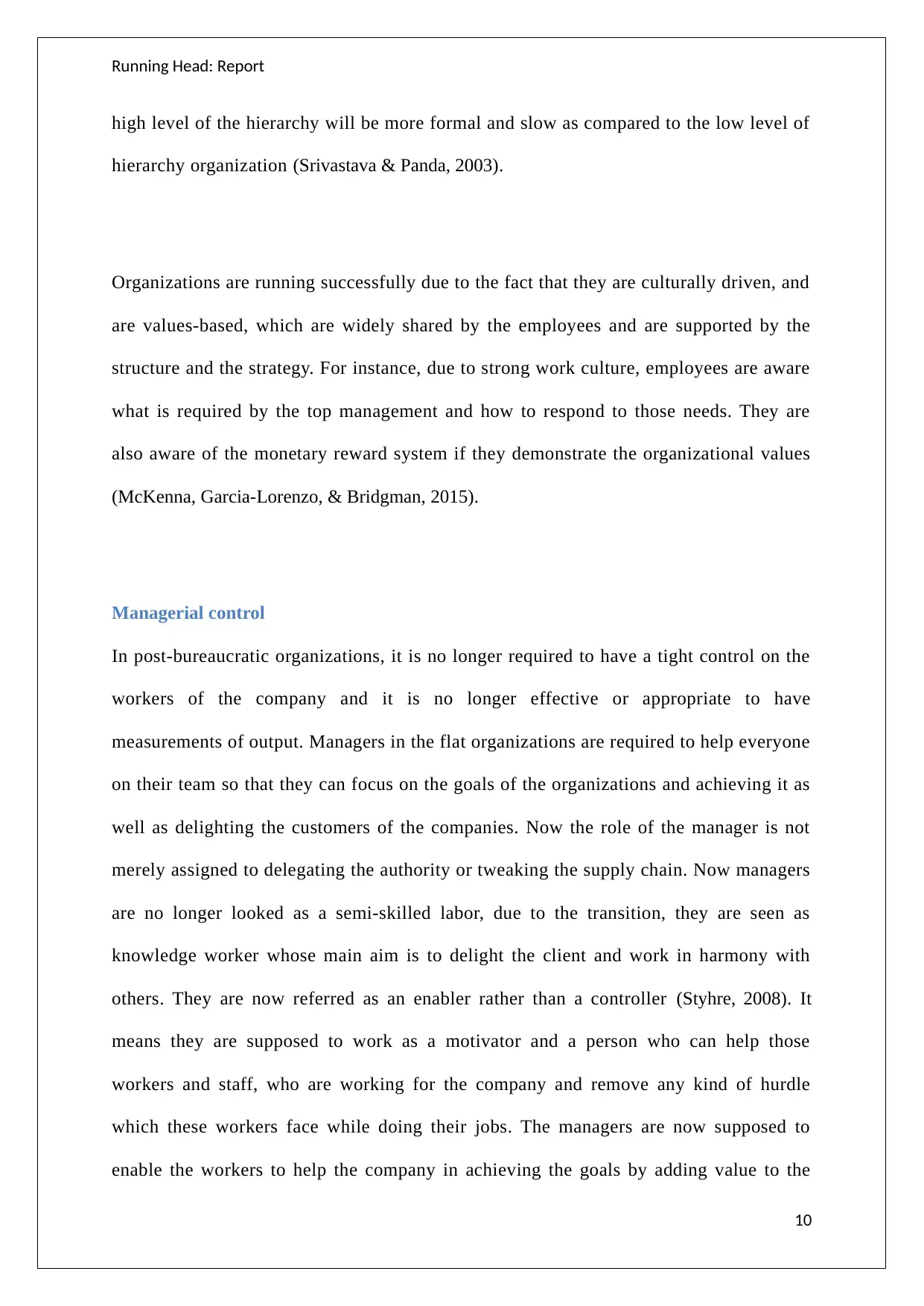
Running Head: Report
high level of the hierarchy will be more formal and slow as compared to the low level of
hierarchy organization (Srivastava & Panda, 2003).
Organizations are running successfully due to the fact that they are culturally driven, and
are values-based, which are widely shared by the employees and are supported by the
structure and the strategy. For instance, due to strong work culture, employees are aware
what is required by the top management and how to respond to those needs. They are
also aware of the monetary reward system if they demonstrate the organizational values
(McKenna, Garcia-Lorenzo, & Bridgman, 2015).
Managerial control
In post-bureaucratic organizations, it is no longer required to have a tight control on the
workers of the company and it is no longer effective or appropriate to have
measurements of output. Managers in the flat organizations are required to help everyone
on their team so that they can focus on the goals of the organizations and achieving it as
well as delighting the customers of the companies. Now the role of the manager is not
merely assigned to delegating the authority or tweaking the supply chain. Now managers
are no longer looked as a semi-skilled labor, due to the transition, they are seen as
knowledge worker whose main aim is to delight the client and work in harmony with
others. They are now referred as an enabler rather than a controller (Styhre, 2008). It
means they are supposed to work as a motivator and a person who can help those
workers and staff, who are working for the company and remove any kind of hurdle
which these workers face while doing their jobs. The managers are now supposed to
enable the workers to help the company in achieving the goals by adding value to the
10
high level of the hierarchy will be more formal and slow as compared to the low level of
hierarchy organization (Srivastava & Panda, 2003).
Organizations are running successfully due to the fact that they are culturally driven, and
are values-based, which are widely shared by the employees and are supported by the
structure and the strategy. For instance, due to strong work culture, employees are aware
what is required by the top management and how to respond to those needs. They are
also aware of the monetary reward system if they demonstrate the organizational values
(McKenna, Garcia-Lorenzo, & Bridgman, 2015).
Managerial control
In post-bureaucratic organizations, it is no longer required to have a tight control on the
workers of the company and it is no longer effective or appropriate to have
measurements of output. Managers in the flat organizations are required to help everyone
on their team so that they can focus on the goals of the organizations and achieving it as
well as delighting the customers of the companies. Now the role of the manager is not
merely assigned to delegating the authority or tweaking the supply chain. Now managers
are no longer looked as a semi-skilled labor, due to the transition, they are seen as
knowledge worker whose main aim is to delight the client and work in harmony with
others. They are now referred as an enabler rather than a controller (Styhre, 2008). It
means they are supposed to work as a motivator and a person who can help those
workers and staff, who are working for the company and remove any kind of hurdle
which these workers face while doing their jobs. The managers are now supposed to
enable the workers to help the company in achieving the goals by adding value to the
10
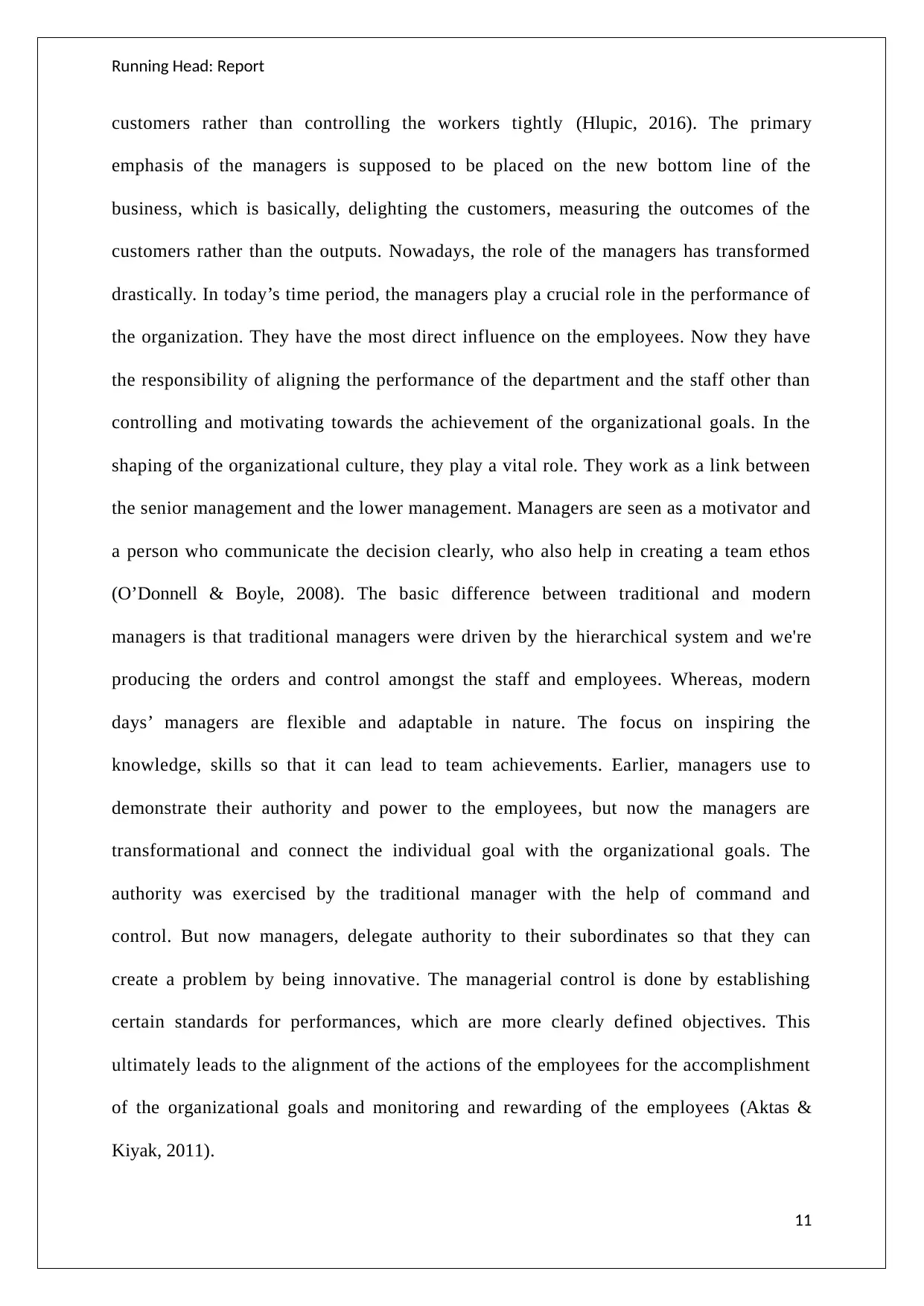
Running Head: Report
customers rather than controlling the workers tightly (Hlupic, 2016). The primary
emphasis of the managers is supposed to be placed on the new bottom line of the
business, which is basically, delighting the customers, measuring the outcomes of the
customers rather than the outputs. Nowadays, the role of the managers has transformed
drastically. In today’s time period, the managers play a crucial role in the performance of
the organization. They have the most direct influence on the employees. Now they have
the responsibility of aligning the performance of the department and the staff other than
controlling and motivating towards the achievement of the organizational goals. In the
shaping of the organizational culture, they play a vital role. They work as a link between
the senior management and the lower management. Managers are seen as a motivator and
a person who communicate the decision clearly, who also help in creating a team ethos
(O’Donnell & Boyle, 2008). The basic difference between traditional and modern
managers is that traditional managers were driven by the hierarchical system and we're
producing the orders and control amongst the staff and employees. Whereas, modern
days’ managers are flexible and adaptable in nature. The focus on inspiring the
knowledge, skills so that it can lead to team achievements. Earlier, managers use to
demonstrate their authority and power to the employees, but now the managers are
transformational and connect the individual goal with the organizational goals. The
authority was exercised by the traditional manager with the help of command and
control. But now managers, delegate authority to their subordinates so that they can
create a problem by being innovative. The managerial control is done by establishing
certain standards for performances, which are more clearly defined objectives. This
ultimately leads to the alignment of the actions of the employees for the accomplishment
of the organizational goals and monitoring and rewarding of the employees (Aktas &
Kiyak, 2011).
11
customers rather than controlling the workers tightly (Hlupic, 2016). The primary
emphasis of the managers is supposed to be placed on the new bottom line of the
business, which is basically, delighting the customers, measuring the outcomes of the
customers rather than the outputs. Nowadays, the role of the managers has transformed
drastically. In today’s time period, the managers play a crucial role in the performance of
the organization. They have the most direct influence on the employees. Now they have
the responsibility of aligning the performance of the department and the staff other than
controlling and motivating towards the achievement of the organizational goals. In the
shaping of the organizational culture, they play a vital role. They work as a link between
the senior management and the lower management. Managers are seen as a motivator and
a person who communicate the decision clearly, who also help in creating a team ethos
(O’Donnell & Boyle, 2008). The basic difference between traditional and modern
managers is that traditional managers were driven by the hierarchical system and we're
producing the orders and control amongst the staff and employees. Whereas, modern
days’ managers are flexible and adaptable in nature. The focus on inspiring the
knowledge, skills so that it can lead to team achievements. Earlier, managers use to
demonstrate their authority and power to the employees, but now the managers are
transformational and connect the individual goal with the organizational goals. The
authority was exercised by the traditional manager with the help of command and
control. But now managers, delegate authority to their subordinates so that they can
create a problem by being innovative. The managerial control is done by establishing
certain standards for performances, which are more clearly defined objectives. This
ultimately leads to the alignment of the actions of the employees for the accomplishment
of the organizational goals and monitoring and rewarding of the employees (Aktas &
Kiyak, 2011).
11
⊘ This is a preview!⊘
Do you want full access?
Subscribe today to unlock all pages.

Trusted by 1+ million students worldwide
1 out of 16
Related Documents
Your All-in-One AI-Powered Toolkit for Academic Success.
+13062052269
info@desklib.com
Available 24*7 on WhatsApp / Email
![[object Object]](/_next/static/media/star-bottom.7253800d.svg)
Unlock your academic potential
Copyright © 2020–2025 A2Z Services. All Rights Reserved. Developed and managed by ZUCOL.





